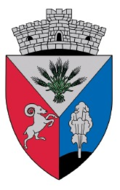Loamneș
|
Loamneș Ladmesch Ladamos |
||||
|
||||
| Basic data | ||||
|---|---|---|---|---|
| State : |
|
|||
| Historical region : | Transylvania | |||
| Circle : | Sibiu | |||
| Coordinates : | 45 ° 56 ' N , 24 ° 4' E | |||
| Time zone : | EET ( UTC +2) | |||
| Height : | 397 m | |||
| Area : | 100.84 km² | |||
| Residents : | 2,997 (October 20, 2011) | |||
| Population density : | 30 inhabitants per km² | |||
| Postal code : | 557120 | |||
| Telephone code : | (+40) 02 69 | |||
| License plate : | SB | |||
| Structure and administration (as of 2016) | ||||
| Community type : | local community | |||
| Structure : | Loamneș, Alămor , Armeni , Hașag , Mândra , Sădinca | |||
| Mayor : | Maria Greavu ( PSD ) | |||
| Postal address : | Str. Principală, no. 230 loc. Loamneș, jud. Sibiu, RO-557120 |
|||
| Website : | ||||
Loamneș (outdated Loamnăș ; German Ladmesch or Ladendorf , Hungarian Ladamos ) is a municipality in the Sibiu County , in Transylvania , Romania .
Geographical location
The municipality of Loamneş is located in the Zekesch Highlands ( Podişul Secaşelor ) in the southwest of the Transylvanian Basin in the west of the Sibiu district. In the historic district of Kisenyed in the Lower Weissenburg County , the place Loamneș is located on the upper reaches of the Vișa ( Weißbach ), a left tributary of the Târnava Mare ( Great Kokel ). On the district road ( Drum județean ) DJ 106B and the Sibiu-Copşa Mică railway line , the elongated village is located about 13 km from the small town of Ocna Sibiului ( Salzburg ) and also about 25 kilometers north of the district capital Sibiu ( Hermannstadt ).
Of the approximately 10,000 hectares of the community area, almost 88% is farmed; about 6% are forested.
history
The place was first mentioned in a document in 1320. In the 19th century, the place belonged to the Hungarian noble Bethlen family . In the second half of the 19th century, according to František Pošepný, “ a blue-gray, soda-containing muddy water with a temperature of 9 ° R ” was discovered on the site . Furthermore, natural gas with up to 99% methane is extracted in the area of the municipality .
The steam locomotives were refueled with water in the Loamneș train station .
The main sources of income for the population are agriculture and livestock.
population
The population of the municipality developed as follows:
| census | Ethnic composition | |||||||
|---|---|---|---|---|---|---|---|---|
| year | population | Romanians | Hungary | German | other | |||
| 1850 | 3,754 | 2,946 | 207 | 405 | 196 | |||
| 1920 | 5,230 | 4,344 | 273 | 509 | 104 | |||
| 1941 | 5,833 | 5,085 | 175 | 516 | 12 | |||
| 1977 | 4,864 | 4,439 | 43 | 374 | 8th | |||
| 2011 | 2,997 | 2,887 | 16 | 6th | 88 (Roma 9) | |||
Since 1850 the highest number of inhabitants (6040) in the area of today's municipality, at the same time that of the Romanians (5448), was reached in 1956. The highest number of Romanian Germans was registered in 1941, that of Magyars (386) in 1910 and that of Roma (196) in 1850. Furthermore, in 1880 one of them confessed to be a Serb and in 1910 and 1956 one as a Slovak .
Attractions
- In Loamneş the Romanian Orthodox Church Sf. Arhangheli , built 1805–1810 and the tower around 1885, are listed as historical monuments.
Web links
Individual evidence
- ↑ 2011 census in Romania ( MS Excel ; 1.3 MB)
- ^ Dictionary of the localities in Transylvania
- ↑ a b Heinz Heltmann, Gustav Servatius (Ed.): Travel Guide Siebenbürgen. Kraft, Würzburg 1993, ISBN 3-8083-2019-2 .
- ^ František Pošepný: Studies from the Saline region of Transylvania . In: Yearbook of the Imperial Royal Geological Institute . XXI. Volume, Vienna 1871, p. 143. Text online .
- ↑ Information on the municipality's website , accessed on January 16, 2015 (Romanian).
- ↑ Census, last updated November 4, 2008 (Hungarian; PDF; 1.1 MB)
- ↑ List of historical monuments of the Romanian Ministry of Culture, updated 2010 (PDF; 7.10 MB)



